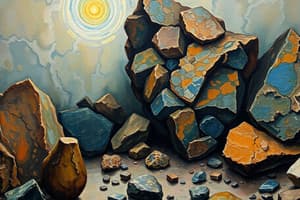Podcast
Questions and Answers
Which of the following characteristics are shared by all minerals? (Select all that apply)
Which of the following characteristics are shared by all minerals? (Select all that apply)
- Liquid
- Natural (correct)
- Inorganic (correct)
- Crystalline (correct)
What is a mineral?
What is a mineral?
A natural, inorganic, crystalline solid with a definite chemical composition.
All minerals are manmade.
All minerals are manmade.
False (B)
What is the least useful property of minerals for identification?
What is the least useful property of minerals for identification?
What does the Mohs hardness scale measure?
What does the Mohs hardness scale measure?
A mineral's tendency to split along definite planes is called _____
A mineral's tendency to split along definite planes is called _____
What is an example of a mineral that exhibits fluorescence?
What is an example of a mineral that exhibits fluorescence?
Match the following minerals with their properties:
Match the following minerals with their properties:
All minerals have a crystalline structure.
All minerals have a crystalline structure.
What is the main element that constitutes most minerals in the Earth's crust?
What is the main element that constitutes most minerals in the Earth's crust?
Flashcards are hidden until you start studying
Study Notes
Minerals Overview
- Minerals are natural substances made of single elements or compounds, not manmade.
- Cannot be broken down into simpler substances; elements are the simplest form.
Common Elements in Earth's Crust
- Oxygen constitutes 46%
- Silicon accounts for 29%
- Remaining 25% includes Aluminum (Al), Iron (Fe), Calcium (Ca), Sodium (Na), Potassium (K), and Magnesium (Mg).
Mineral Characteristics
- Natural: Occurs in nature.
- Inorganic: Non-living and never was alive.
- Crystalline: Atoms are arranged in an orderly pattern.
- Definite Chemical Composition: Each mineral has a specific chemical formula (e.g., SiO2 for Quartz).
- Solid: Minerals exist as solids, not in gaseous or liquid forms.
Physical Properties of Minerals
Color
- First impression of a mineral, but it's not reliable due to variations in color across minerals.
Streak
- The true color of a mineral when ground into powder; minerals harder than "7" on the Mohs scale may not produce a streak.
Hardness
- Resistance to scratching; classified on the Mohs Hardness Scale from 1 (Talc) to 10 (Diamond).
- Hardness level depends on the packing of atoms in the mineral.
Cleavage
- Tendency to split along specific planes of weakness; described as basal, cubic, or rhombohedral cleavage based on the angles.
Fracture
- Breaks irregularly, producing jagged edges; types include conchoidal, uneven, and fibrous fractures.
Luster
- Appearance of light reflecting off a mineral; categorized into:
- Metallic: Resembles polished metal (e.g., Galena, Pyrite).
- Nonmetallic: Includes terms like vitreous (glass-like), pearly, waxy, earthy, and adamantine (brilliant shine).
Identification of Minerals
- Physical properties used for identification: color, streak, hardness, cleavage, fracture, luster.
Special Properties of Minerals
Magnetism
- Some minerals are attracted to magnets due to the presence of iron, cobalt, or nickel.
Double Refraction
- An optical property where viewing through a mineral results in a doubled image (e.g., Calcite).
Fluorescence
- Some minerals (e.g., Fluorite) can glow under ultraviolet (UV) light.
Studying That Suits You
Use AI to generate personalized quizzes and flashcards to suit your learning preferences.




